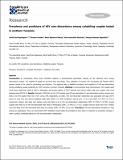Prevalence and Predictors of HIV Sero-discordance among Cohabiting Couples Tested in northern Tanzania
View/
Publication Date
2015-11-23Type
Article, Journalviews
downloads
Metadata
Show full item recordCitation
Ngilangwa, D.P., Ochako, R., Mboya, B.A., Noronha, R., & Mgomella, G.S. (2015). Prevalence and predictors of HIV sero-discordance among cohabiting couples tested in northern Tanzania. The Pan African Medical Journal, 22.
Abstract/
Introduction: In sub-Saharan Africa where HIV/AIDS epidemic is predominantly generalized, majority of HIV infections occur among heterosexual couples. The majority of people do not know their sero-status. Thus, utilisation of Couples' HIV Counselling and Testing (CHCT) services remain to be critical in preventing new infections. The objective was to establish prevalence and predictors of HIV sero-discordance among cohabiting couples presenting for CHCT services in northern Tanzania. Methods: A cross-sectional study inteveviewed 1,333 couples aged 18-49 years tested from 2005 to 2007 in Kilimanjaro and Arusha regions. A CHCT checklist was used to collect data from couples. Data were analyzed using STATA 10. Results: Generally, 220(16%) out of 1,333 couples were HIV sero-discordant. In sero-discordance unions, women were likely to be HIV positive than men (71% versus 29% respectively p<0.001). HIV sero-discordant relationship was associated with age (35-45 years) for both men and women (Adjusted Odds Ratio (AOR): 2.3, 95% Confidence Interval (CI): 1.7-3.2) and (AOR: 2.6, 95% CI 1.9-3.7) respectively. Women with older men partners were less likely to be in HIV sero-discordance relationships (AOR: 0.5 95% CI 0.3-09). Arusha couples were likely to be HIV sero-discordant than those of Kilimanjaro (AOR: 2.3 95% CI 1.7-3.2). Couples living far away from CHCT centres were less likely to be sero-discordant than those live nearby (AOR: 0.4 95% CI 0.2-0.9). Conclusion: HIV sero-discordance prevalence is high among our participants. Thus, we recommend CHCT utilization should widely be promoted as entry point in treatment as prevention strategy in order to protect uninfected partners in HIV sero-discordance relationships.
Further Details
© David Paul Ngilangwa et al. The Pan African Medical Journal - ISSN 1937-8688. This is an Open Access article distributed under the terms of the Creative Commons Attribution License (http://creativecommons.org/licenses/by/2.0), which permits unrestricted use, distribution, and reproduction in any medium, provided the original work is properly cited.
Publisher
PanAfrican Medical JournalISSN
1937- 8688Collections
- General - GEN [367]

